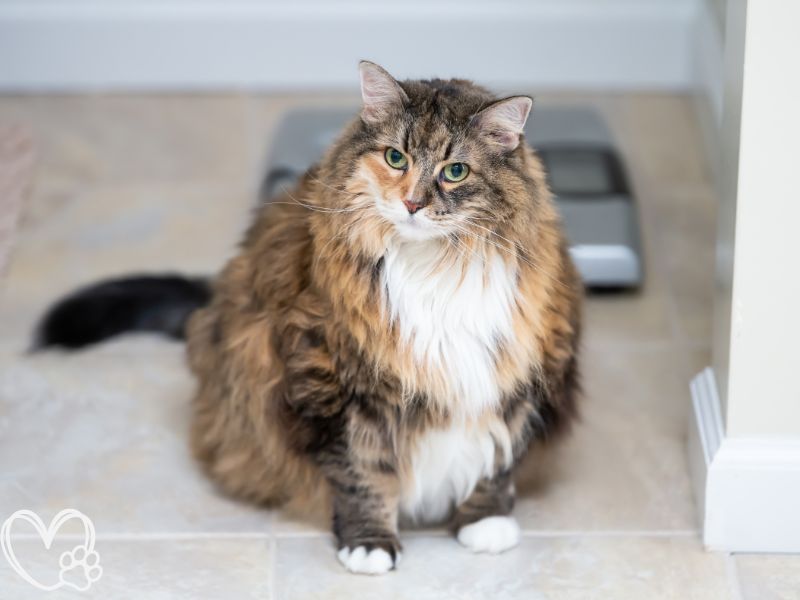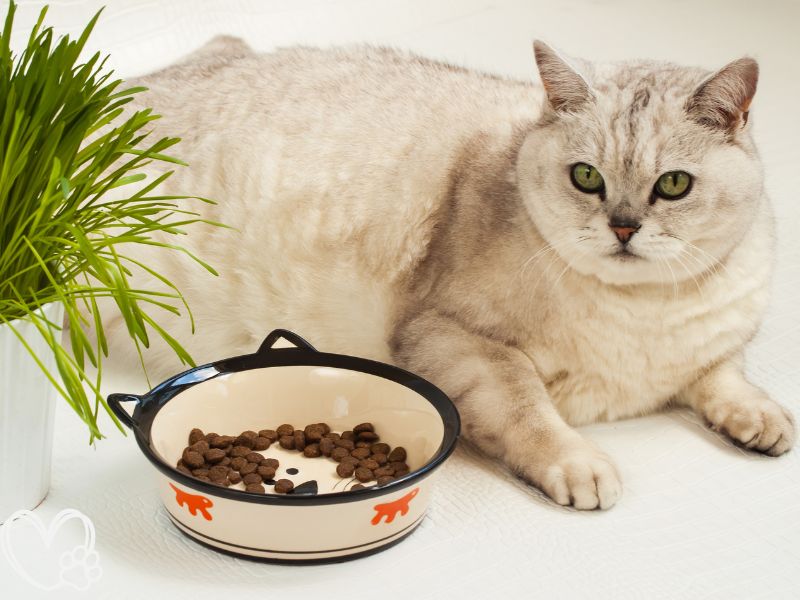Effective management of a pet’s weight is an essential aspect of responsible pet ownership that directly influences their overall health and longevity. Just like in humans, maintaining a healthy weight in pets can significantly reduce the risks of developing various health issues. Research indicates that approximately 56% of dogs and 60% of cats in the United States are classified as overweight or obese. This alarming statistic highlights a pressing concern for pet owners and veterinary professionals alike.
Obesity in pets can lead to a multitude of serious health complications. One of the foremost issues associated with excessive weight is diabetes mellitus, a condition that occurs when the body cannot regulate blood sugar levels effectively. Pets that are overweight are not only at a heightened risk of developing diabetes but also encounter an increased likelihood of suffering from joint problems. The excess weight puts additional strain on their joints, leading to arthritis and discomfort, which can severely diminish their quality of life.
Moreover, carrying excess weight can have detrimental effects on a pet’s cardiovascular health. Obese pets are more susceptible to heart disease, which can lead to a reduced lifespan and ongoing health challenges. Furthermore, weight influences the respiratory system; overweight pets may experience breathing difficulties, particularly in those with pre-existing conditions. These factors underline the importance of proactive weight management as a preventative health measure. By monitoring and addressing a pet’s weight, owners can help mitigate the risks associated with obesity, promoting a healthier and more active lifestyle.
In summary, the significance of managing a pet’s weight cannot be overstated. Understanding the potential risks and implications of obesity enables pet owners to take informed actions that contribute to their pet’s health and well-being.
Identifying Your Pet’s Ideal Weight

Determining your pet’s ideal weight is crucial for their overall health and well-being. Each pet has a unique ideal weight that is influenced by several factors including breed, age, and body condition. Understanding these elements enables pet owners to make informed decisions about their pet’s weight management.
The first step in assessing your pet’s weight is to understand the breed standards. Different breeds have varying weight ranges that are considered healthy. For example, a Labrador Retriever will have a different ideal weight compared to a Chihuahua. Consulting breed-specific guidelines can provide a good benchmark. Additionally, age plays a significant role; younger pets may require different weight considerations than older pets. Puppies and kittens typically require more weight due to growth and development, whereas senior pets may need to maintain a more stable weight to avoid health complications.
Another effective method for assessing your pet’s weight is to utilize body condition scoring systems (BCS). These systems allow pet owners to evaluate the body fat percentage and muscle condition of their pets through a simple scoring method. Resources, such as visual guides that portray pets at various condition scores, can help you gauge whether your pet falls within the healthy range. You can often feel your pet’s ribs without excess fat covering, and they should have a noticeable waist when viewed from above—these are critical markers to consider when assessing body condition.
By effectively using breed-specific guidelines and body condition scores, pet owners can gain valuable insights into their pet’s weight management. This knowledge will not only help in achieving that ideal weight but also ensure that your pet remains healthy and active throughout their life.
Consulting Your Veterinarian

When it comes to managing your pet’s weight, one of the most crucial steps is to consult with a veterinarian. Vets possess specialized knowledge and expertise that can be invaluable in creating a personalized weight management plan tailored specifically to your pet’s needs. A thorough examination by a veterinarian will allow them to assess your pet’s overall health, analyze their weight, and determine whether there are underlying medical conditions affecting their body condition.
During the consultation, your veterinarian will likely perform a complete health assessment, which may include checking for metabolic disorders, hormonal imbalances, or other health issues that could impede weight loss efforts. Recognizing that each pet is unique, vets can help in devising a strategy that considers factors such as age, breed, current medical status, and lifestyle. This individualized approach helps ensure that the pet’s weight management plan is both safe and effective.
In addition to evaluating your pet’s health, veterinarians can offer guidance on nutritional needs and exercise regimens that are appropriate for your pet’s specific lifestyle and weight goals. They can recommend high-quality diet options while taking into account any sensitivities or allergies, which can aid in promoting a healthy metabolism and weight. A veterinarian’s recommendations might also include a gradual weight loss plan to avoid any health complications associated with rapid changes.
Moreover, regular follow-up appointments with your veterinarian will allow for monitoring your pet’s progress, making necessary adjustments to the weight management plan. These sessions provide opportunities for you to address any concerns and ensure the methods being implemented are yielding positive results. Prioritizing professional veterinary advice is essential when embarking on the journey to manage your pet’s weight effectively.
Portion Control and Feeding Practices

Managing your pet’s weight effectively requires a deliberate approach to portion control and feeding practices. The first step is to determine the appropriate portion sizes for your pet based on its unique requirements, which can vary by breed, age, and activity level. Consulting with a veterinarian is advisable to ascertain the ideal caloric intake for your specific pet’s weight and lifestyle. It is essential to follow the recommended serving sizes on pet food packaging, as these guidelines are designed to optimize your pet’s health and weight.
Frequency of meals also plays a crucial role in managing your pet’s weight. For most pets, dividing daily food intake into two or more smaller meals can enhance digestion and help prevent overeating. This method not only allows for better absorption of nutrients but can also stabilize energy levels throughout the day. It is important to establish a consistent feeding schedule to create a routine for your pet, making it easier to monitor their feeding behavior and react to any changes in appetite or weight.
When selecting food for your pet, prioritize high-quality, nutritionally balanced options that align with their specific dietary needs. For pets that tend to gain weight easily, consider feeding options that are lower in calories or formulated for weight management. Avoid free feeding, as this practice can lead to unregulated eating habits and obesity. Instead, measure out the food using a scale or measuring cup to ensure accuracy. By taking these steps, pet owners can attain better control over their pet’s food intake, ultimately supporting a healthy lifestyle and maintaining a proper pet’s weight.
Understanding Pet Food Labels

Reading and interpreting pet food labels is a crucial step in managing your pet’s weight effectively. The first element to consider is the calorie count, which is typically displayed on the package. Understanding how many calories are contained in a serving will help you maintain your pet’s weight within a healthy range. Many manufacturers also provide feeding guidelines based on the pet’s weight; however, these suggestions can sometimes be misleading, so careful consideration of your individual pet’s needs is necessary.
Next, take a look at the ingredients list. This list is typically sorted by weight, with the heaviest ingredients listed first. High-quality sources of protein, such as chicken or fish, should be among the top three ingredients. It is advisable to avoid the use of fillers such as corn or soy, as these do not contribute significantly to your pet’s nutritional needs and may lead to weight gain. Additionally, be aware of by-products, as these can vary in quality.
Nutritional content is also key in understanding pet food labels. Essential nutrients such as fats, carbohydrates, vitamins, and minerals should be present in appropriate amounts, as they play a critical role in your pet’s overall health and weight management. For instance, foods high in fiber can aid digestion and help your pet feel fuller longer, thereby supporting efforts to reduce caloric intake. Look for products labeled as “light” or “weight management,” as these options often have a lower caloric density.
Ultimately, proper understanding of pet food labels is integral to making informed decisions that support your pet’s weight management goals. By prioritizing quality ingredients and monitoring caloric intake, you can contribute significantly to your pet’s overall health and well-being.
Encouraging Exercise: Fun and Engaging Activities

One of the most effective strategies for managing your pet’s weight is to encourage regular exercise through engaging activities. Physical activity plays a critical role in your pet’s overall health and can help maintain a healthy weight. Whether you have a dog, cat, or other pets, incorporating fun routines can make exercise enjoyable and rewarding for both you and your furry companion.
For dogs, outdoor activities are often the most stimulating. Daily walks, runs, or visits to the dog park provide essential exercise while allowing your pet to explore new environments and socialize with other dogs. Additionally, consider interactive games like fetch or frisbee, which not only promote movement but also strengthen your bond. If you find yourself in inclement weather, indoor options such as obstacle courses made from household items or tug-of-war can keep your dog physically active and mentally engaged.
Cats, on the other hand, require slightly different approaches to encourage physical activity. Since many domestic cats spend a significant amount of time indoors, engaging them in play that stimulates their hunting instincts can be beneficial for managing their weight. Toys that mimic prey, like feather wands or laser pointers, can encourage your cat to leap, chase, and pounce, thus promoting a good workout. Providing vertical spaces, such as cat trees or shelves, can also encourage climbing and exploration, contributing to an active lifestyle.
Regardless of the type of pet, it is important to establish a routine that incorporates regular playtime and consistent exercise. Monitoring your pet’s progress can help you determine the effectiveness of your activities in managing its weight. By integrating fun and engaging exercises into your pets’ daily life, you will contribute significantly to their overall health and well-being.
Monitoring Progress and Adjusting Plans

Effectively managing your pet’s weight requires a systematic approach, which includes regular monitoring and timely adjustments to their diet and exercise regimen. One of the most effective ways to track progress is through consistent weigh-ins. It is advisable to weigh your pet at least once a month, preferably using the same scale, and at the same time of day. This helps ensure that the data is reliable and can be compared over time.
In addition to regular weigh-ins, using a body condition scoring system can provide a comprehensive view of your pet’s body fat and overall health. This simple scale typically ranges from 1 to 9, where a score of 5 signifies a healthy weight. Assessing your pet’s body condition can help you better understand if they are underweight, overweight, or at their ideal weight. It is an important practice to regularly evaluate their score, adjusting feeding portions and exercise as needed to help them maintain a healthy weight.
Another beneficial strategy is to maintain a weight journal. This journal can include details such as weight records, dietary changes, exercise routines, and even your pet’s behavior and energy levels. Recording such information not only helps in tracking progress but also provides valuable insights into what works best for your pet’s weight management. If you observe stagnation or regression in their weight loss journey, revisit their calorie intake and exercise plan, making necessary adjustments as per the observations noted in your journal.
By combining these monitoring techniques, you can create a dynamic weight management plan tailored specifically for your pet. This approach enables you to celebrate milestones in their weight loss journey while also addressing challenges as they arise. Consequently, your pet will be healthier and more active, improving their quality of life significantly.
Understanding Behavioral Factors Contributing to Weight Gain

When assessing an animal’s weight management, it is essential to consider the psychological and emotional factors that can contribute to your pet’s weight gain. Just like humans, pets can develop emotional eating habits that lead them to consume excess calories when they experience stress, anxiety, or boredom. For instance, a dog may gravitate toward food as a source of comfort during thunderstorms or changes in the household dynamic, inadvertently leading to an increase in their body weight.
The role of treats in a pet’s diet cannot be overlooked. While celebrating small victories or offering rewards for good behavior is a common practice, the excessive use of treats can result in unintended consequences for your pet’s weight. It is crucial to evaluate the quantity and quality of treats given; opting for low-calorie options or reducing treat sizes can significantly impact how much weight a pet may gain over time.
Moreover, owner habits and routines play a pivotal role in shaping a pet’s behaviors related to food. If an owner frequently snacks or shares meals with their pet, the tendency to indulge may escalate. Establishing consistent feeding schedules and maintaining firm boundaries regarding table scraps can help prevent the likelihood of unhealthy weight gain. Instead, pet owners should focus on healthy portion sizes and nutritious food options to promote a balanced diet.
To effectively tackle the behavioral aspects that contribute to a pet’s weight, pet owners can introduce strategies that encourage active play and mental stimulation. Engaging pets in regular exercise and interactive gaming can help shift their focus from food-related comfort to more fulfilling activities. By adopting a more mindful approach to their furry friends’ eating habits and physical engagement, owners can create an environment that promotes healthier behaviors and ultimately manages their pet’s weight more efficiently.
Maintaining Long-term Healthy Weight Management

Achieving a healthy weight for your pet is a significant milestone, but the journey does not end there. Maintaining your pet’s weight requires a sustained commitment to a balanced lifestyle, routine veterinary check-ups, and active involvement from all family members. These strategies are essential to ensure that the weight management achieved is not only maintained but also contributes to the overall health and happiness of your pet.
First and foremost, establishing a balanced lifestyle for your pet involves a combination of proper diet and regular exercise. Consult with your veterinarian to create a suitable feeding plan that meets your pet’s nutritional needs without exceeding calorie intake. This plan should include high-quality pet food, appropriate portion sizes, and healthy treats that can support your pet’s ideal weight. Regular physical activity is equally important, as it helps to burn calories and maintain muscle mass. Engaging your pet in daily walks, play sessions, and mentally stimulating activities can make a significant difference in maintaining their weight.
Additionally, routine check-ups with your veterinarian play a crucial role in long-term weight management. These visits help you monitor your pet’s weight trends and address any potential health issues that could arise due to weight fluctuations. Your veterinarian can also provide ongoing advice on nutrition and exercise tailored to your pet’s specific needs. If your pet is prone to weight gain or loss, these check-ups become even more vital in establishing preventive measures.
Lastly, involving family members in your pet care routine fosters a supportive environment. Educate all household members about the importance of maintaining your pet’s weight and encourage them to partake in feeding, exercising, and monitoring activities. Shared responsibility not only helps maintain consistency but also strengthens the bond between your pet and the family.
By integrating these strategies into your daily routine, you can ensure that your pet maintains a healthy weight, contributing to their overall quality of life.


